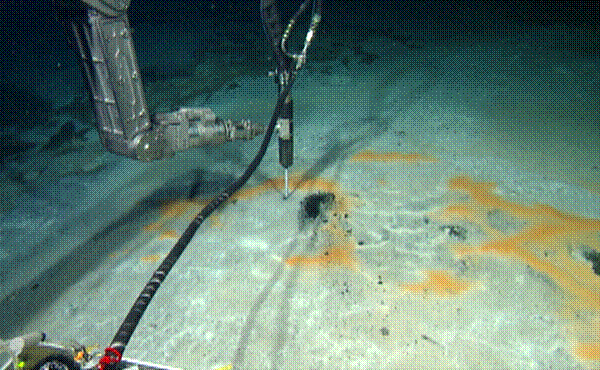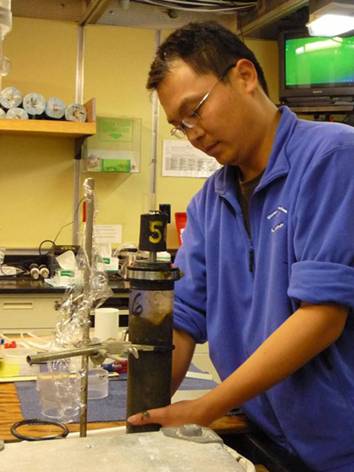|
— Been highlighted and reported by both Nature and Science
A deep-sea methane in situ detection system based on ROV (Remotely Operated Vehicle) has been developed by Dr. Xin Zhang at IOCAS and the Monterey Bay Aquarium Research Institute (MBARI) at US. The results had been published at Geophysical Research Letters1 recently, and had been highlighted and reported by both Nature2 and Science3.
A robotic sub samples the methane content of the sea floor off the coast of southern California. By Monterey Bay Aquarium Research Institute (Nature, doi:10.1038/news.2011.263)
This technique has been used to get the first in situ true methane concentrations at deep-sea sediment in the world by the researchers. The in situ results are 10-20 times high than the traditional methods. So, those results show that methane gas is not only stored inside the gas hydrate, there must be a lot of methane gas saturating at pore water inside the mud. Based on the ROV’s video camera, The titanium pore water probe has been inserted into the deep-sea sediment and suck up pore water, and then a laser beam from a deep-sea laser Raman spectrometer has been used to reveal the amount of methane and other substances in that water such as H2S, pH and SO4.
Prof. Ross Chapman, from the University of British Columbia who studies hydrates thinks this technique is: "It's expensive, but it's useful" . Some other relevant results had been showed by oral presentations at 2009 AGU fall meeting and the 2010 Ocean Sciences meeting. The most recently relevant results also will be showed by oral presentations at OCEANS 2011 Santander Spain meeting at the 7th International Conference on Gas Hydrates (ICGH7). So, this topic has became a new research hotspot in ocean science.
Lead author Zhang Xin, analysing a mud core on board the research vessel Western Flyer. By Nancy Barr/Monterey Bay Aquarium Research Institute (Nature, doi:10.1038/news.2011.263)
There are lots of methane gas at deep-sea sediment, the methane also can combine with H2O to form gas hydrate, and plays a very important role in the global methane cycle and the climate change. Gas hydrate also is a kind of future clean energy, but lack effective detecting methods for now.
As an advanced marine chemical detection technology, this technique can be used at geochemistry of marine sediments, in situ detection of gas hydrates, the ecological system study at the hydrothermal fluid /cool seep areas.
Real time in situ pore water Raman spectra obtained during deployment and displayed in the ROV Doc Ricketts control room at R/V Western Flyer (MBARI). By Xin Zhang/Institute of Oceanology, Chinese Academy of Sciences
References: 1. Zhang, Xin. et al. Geophys. Res. Lett. 38, L08605 (2011). 2. Nature, doi:10.1038/news.2011.263, published online 2 May, 2011. |
|
|

Address: 7 Nanhai Road, Qingdao, Shandong 266071, China
Tel: 86-532-82898902 Fax: 86-532-82898612 E-mail: iocas@qdio.ac.cn





